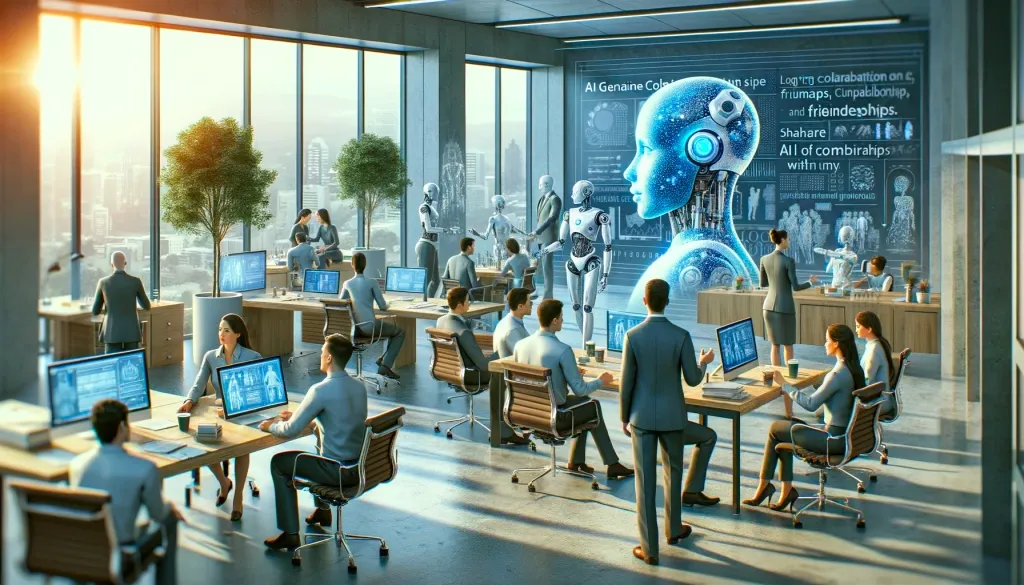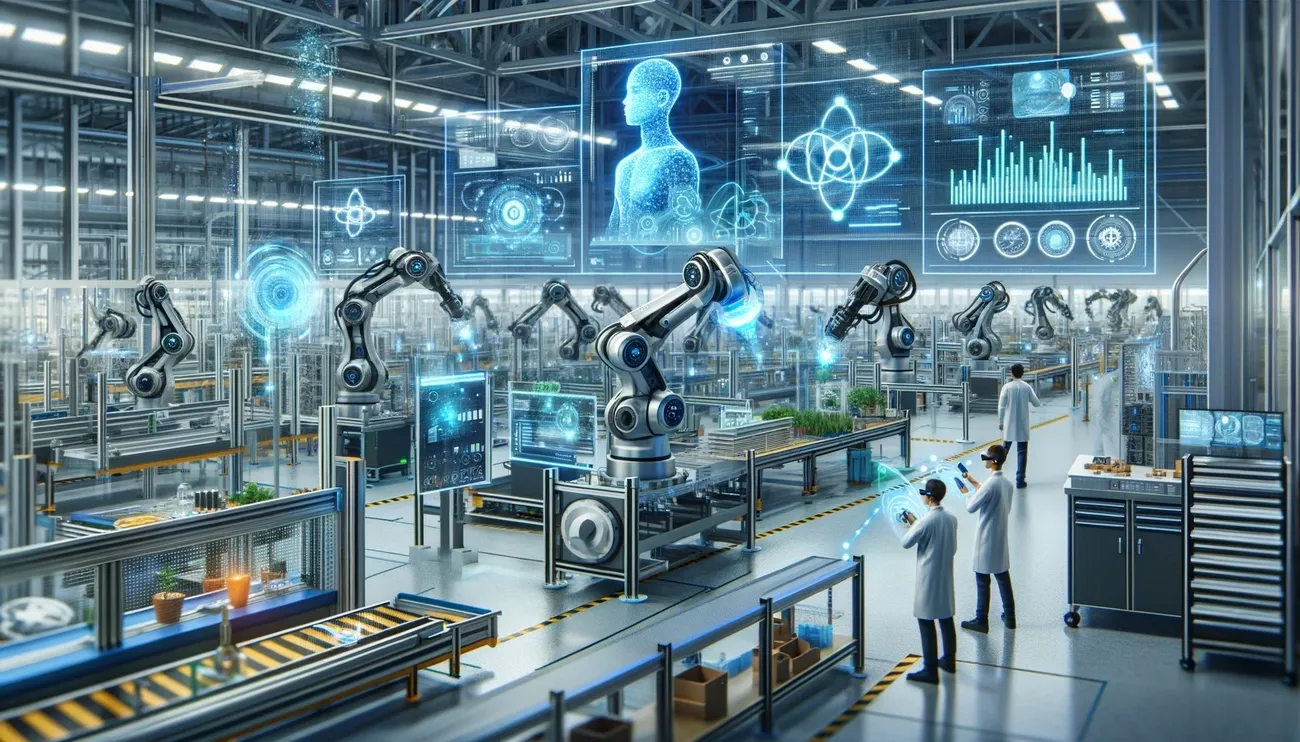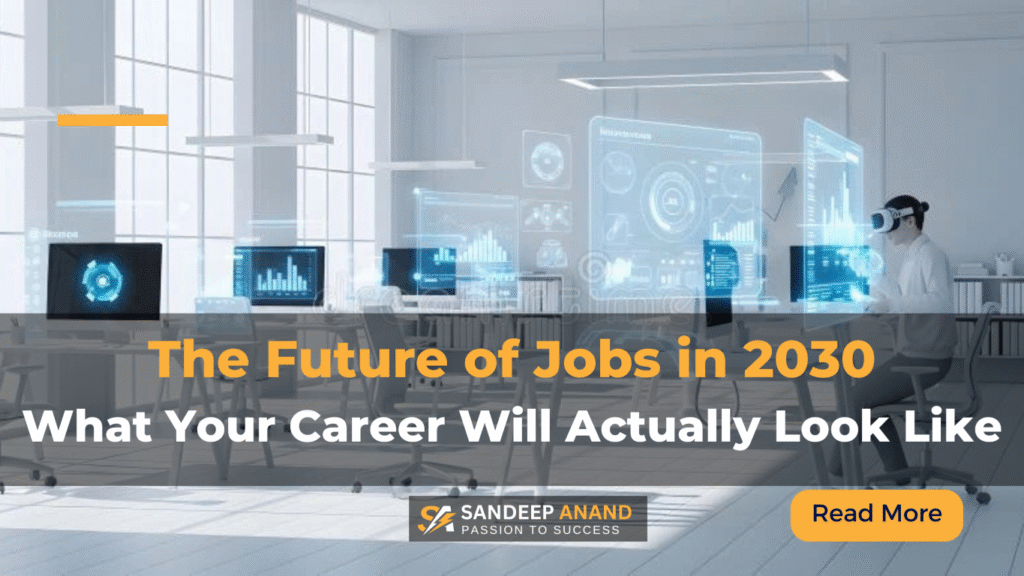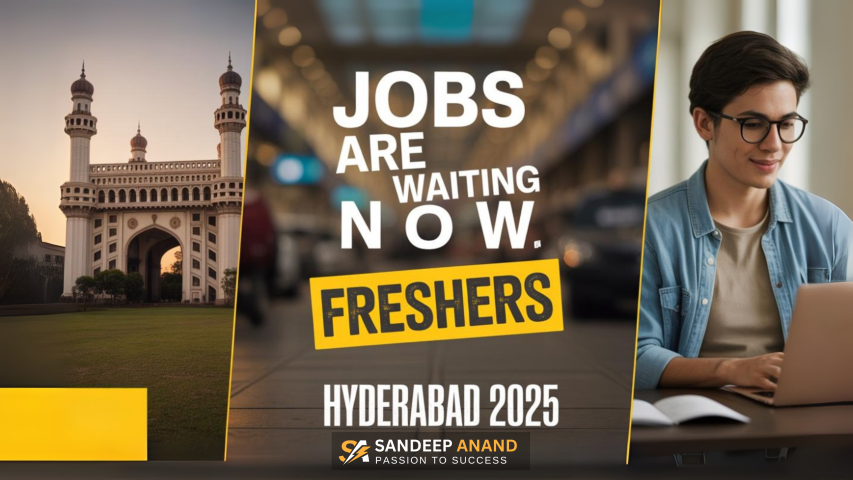Jobs are evolving faster than most people can understand. Workers say they faced more workplace changes last year compared to the previous year. The future looks even more dramatic – 85% of jobs that will exist in 2030 haven’t been created yet.
A major workforce revolution stands right before us. Companies plan to automate 42% of their tasks by 2027, which has grown substantially from 34% in 2020. Work trends point to automation taking over up to 30% of current work hours by 2030, and generative AI speeds up this process. The job market’s future shows a mixed reality – while 83 million jobs might vanish, about 69 million new roles will emerge. The workforce development landscape will need around 12 million people to switch careers by 2030.
This piece explores your career’s potential shape in 2030. From virtual offices that immerse you completely to AI assistants that manage your work, we’ll show you practical ways to stay valuable as future jobs keep evolving.
A day in the life of a 2030 worker

Image Source: On Digital Strategy | Dion Hinchcliffe
The office experience you know today will change drastically by 2030. Innovative technology reshapes our work methods and redefines the meaning of work itself. This creates a new era where humans and machines work together to transform the workplace experience.
Immersive virtual offices
Your “commute” in 2030 might just mean putting on a VR headset. VR and AR technologies create fully immersive office spaces where teams feel physically present while working from different continents. These technologies help employees handle complex tasks better and work together naturally across distances.
Organizations like Siemens and BMW already show remarkable results with these technologies. They report a 32% increase in productivity through immersive teamwork. These virtual workspaces bring significant advantages:
- Zero health risks: Your virtual workspace stays germ-free, unlike traditional offices
- Minimal carbon footprint: Each person needs just one connected computer
- Eliminated bias: Avatars may or may not look like real people, making physical discrimination impossible
- Global talent access: Qualified candidates can join from anywhere worldwide
Knowledge workers believe that half of them will use digital workstations with full-sensory presence from any location by 2030. These virtual environments will expand beyond sight and sound. The “dematerialized office” might engage all human senses to create an experience identical to physical presence.
AI assistants managing tasks
AI assistants will make your 2030 workday remarkably efficient. These smart systems combine generative AI with automation. They interact naturally while handling everything from scheduling to complex workflow management.
Specialized AI assistants simplify or replace certain workflows so you can focus on creative, high-value work. These digital assistants surpass simple chatbots. They access external data sources and maintain memory over time to improve their performance significantly as they learn.
These AI tools adapt to your interactions and priorities. They provide personalized responses and suggestions that match individual requirements. They excel at analyzing large amounts of data live, offering quick insights that lead to faster, informed decisions.
Organizations using AI assistants report 20% better operational efficiency. This improvement will grow as the AI remote work market expands, projected to reach $104.40 billion by 2033.
Global collaboration in real time
Geographical barriers will practically disappear by 2030. Teams will connect through immersive environments that combine physical and virtual collaboration. You can join brainstorming sessions in 3D virtual offices or examine prototypes using AR tools.
Teams spread across time zones will rely on asynchronous workflows. Companies can employ their global talent’s full potential with tools that let people contribute on their schedules. This approach values diverse working styles and reduces project delays to ensure smooth collaboration.
Workers already show they need these capabilities—40% say live collaboration has shifted to asynchronous or separate collaboration tools. Yet, 85% feel satisfied with how well they work together, showing these new tools meet workforce needs.
These technologies offer environmental and practical benefits to 77% of workers who believe a sensory internet would make companies greener. Location won’t define the future workplace. Success will depend on how well you connect, create, and work together across boundaries and time zones.
The future of work trends transforming careers
Career paths are changing faster as we approach 2030. These changes go beyond work locations and alter how professional experiences unfold. Workers preparing for future jobs face new challenges and opportunities.
Tailored employee experiences
Standard career paths no longer work. Companies now understand that their staff wants the same personalization at work as they get elsewhere. Yes, it is true that employees who have technology that boosts productivity show 158% higher engagement. They also have 61% greater intent to stay beyond three years.
This move to personalization changes several aspects of work life:
- AI-powered career pathways: Machine learning predicts the best internal career moves based on individual skills and goals. To cite an instance, IBM’s Career Coach platform has saved the company over $100 million. The platform matches employees to suitable roles, cuts turnover and promotes engagement.
- Customized benefits packages: Traditional benefits no longer work as employees want options that line up with their life situations. Generation Z likes flexible work schedules and adaptable benefits. This explains why they increasingly choose freelance work.
- Tailored learning paths: AI-enhanced learning solutions have improved operational efficiency by up to 15%. They have also boosted productivity by up to 20% in some organizations. These tools create personal development paths that match individual career goals and learning styles.
The modern workforce has people from multiple generations, diverse cultures, and various career goals. They want support that reflects their unique objectives.
Citizen-led state-of-the-art and autonomy
Autonomy has become the life-blood of successful modern workplaces. Companies using AI-driven solutions see a 30% boost in efficiency. This shows what happens when organizations strengthen their employees to make changes.
Citizen-led state-of-the-art – where people actively participate in their company’s digital transformation – alters how companies grow. Companies now let all employees spot opportunities and build solutions instead of limiting innovation to special teams.
PwC serves as a great example. Their 55,000 U.S. partners and staff use digital tools to learn, create, and share ideas. The company’s Digital Lab has over 3,200 employee-built solutions, from bots to data visualization tools.
Companies establish three key elements of digital enablement:
- Digital hubs: Common platforms that turn ideas into reality
- Accelerators: Templates that help teams spot and fix problems
- Automation infrastructure: Adaptable platforms that encourage everyone to join in
McKinsey’s research proves this approach works. Companies that prioritize employee autonomy see higher engagement and productivity. Teams with freedom to handle projects their way produce better results and have happier customers than those following central rules.
Wellness and mental health integration
Mental health now stands at the heart of workplace priorities. The COVID-19 pandemic and tight job market have made wellness professionals more important. Employers now take more responsibility for their staff’s well-being.
The numbers tell the story:
- Depression costs the US economy $210.5 billion – employers pay about half
- 83% of workers felt worse mental health during the pandemic. This included emotional exhaustion (54%), sadness (53%), and irritability (50%)
- Depression treatment cuts absenteeism/presenteeism by 40% to 60%
These findings have expanded workplace well-being. Companies now address hybrid work transitions, competitive benefits, and work-life balance. The health coaching industry has grown to $7.6 billion as people and organizations seek expert help to manage health and stress.
Today’s wellness professionals just need specific skills. These include healthcare system knowledge, legal compliance, inclusive program design, and digital wellness technology use for remote workers.
The 2030 job market will feature more roles focused on total well-being – combining physical, mental, and emotional health. Professionals who offer this complete approach are in high demand. Nutritionist and dietitian roles should grow 7% faster than average through 2033.
Future jobs 2030: new roles and industries
New career categories are emerging as technology and social priorities continue to alter the employment landscape. The job market of 2030 will look different, with roles that barely exist today becoming fundamental to tomorrow’s economy.
Green-collar jobs and sustainability roles
A greener economy represents one of the biggest transformations in future employment. The International Labor Organization predicts that this transformation could create 24 million new jobs globally by 2030. Deloitte’s projections are even more optimistic, suggesting 300 million “green collar” jobs by 2050.
The U.S. Bureau of Labor Statistics identifies two occupations with the fastest projected growth through 2030: wind turbine service technicians and solar photovoltaic installers. The World Economic Forum’s data supports this trend, showing that environmental and renewable energy engineers will grow by more than 40% and 38% respectively by 2030.
The green economy faces a skills shortage despite these positive forecasts. Green job postings have grown 8% each year in the last five years globally, while the talent pool has expanded by just 6% annually. The current green workforce also lacks diversity. Non-Latinx white workers hold over 60% of clean energy jobs in the United States, and women make up only 30% of the workforce.
AI trainers and prompt engineers
Human oversight remains significant throughout the AI revolution. AI trainers who refine artificial intelligence systems are in high demand. Their job postings have increased by more than 150% in the last two years](https://research.com/careers/how-to-become-an-ai-trainer-salary-and-career-paths). These specialists improve AI models’ accuracy, fairness, and effectiveness through dataset management and output evaluation.
These roles offer varying salary ranges. Entry-level AI trainers earn around $50,000 per year, while experienced professionals in tech-heavy industries can earn more than $100,000. Prompt engineers who craft instructions for AI systems also earn well, with ZipRecruiter reporting a national average salary of $62,977 as of June 2025.
The future of prompt engineering remains unclear. Harvard Business Review suggests that the need for prompt engineers might be temporary as AI systems become more fluent in understanding natural language. The global market for prompt engineering is expected to grow at a compound annual growth rate of 32.8% between 2024 and 2030.
Digital wellness and productivity coaches
Our digital lifestyles have created a need for specialists who can help balance technology use and human well-being. Digital wellness coaches guide clients toward healthier relationships with technology. They help manage screen time and address the psychological effects of constant connectivity.
The health coaching market continues to expand and should reach $26.61 billion by 2029. Productivity coaching has become an important part of this sector. These coaches work with clients to improve efficiency through individual-specific strategies for time management, goal setting, and managing distractions.
The success of these emerging roles will depend on market demands and technological developments. They offer exciting opportunities for people who want to pioneer the future job market by combining specialized technical knowledge with human problem-solving and interpersonal skills.
The decline of traditional roles and how to pivot
Technology creates exciting new career paths but could make millions of current jobs obsolete. People need to know which roles might disappear and how to direct their careers in tomorrow’s job market.
Jobs most at risk of automation
Automation will affect employment dramatically, but not equally across all sectors. Activities that make up up to 30% of hours worked today could be automated by 2030—generative AI speeds up this trend. Jobs that face the biggest risk typically involve predictable, repetitive tasks that machines do well.
The data shows several job categories heading toward major decline:
- Administrative roles: Clerical positions could drop by 1.6 million jobs, with administrative assistants losing 710,000 positions
- Customer service and sales: Retail salespersons might lose 830,000 positions, while cashier jobs could shrink by 630,000
- Data processing jobs: AI’s growing accuracy and scale threatens bookkeeping, accounting, and financial modeling
- Basic content creation: A 2024 Pew Research Center report shows AI could take over 30% of media jobs by 2035
AI tools already analyze legal documents with 90% accuracy, which puts paralegal jobs at risk. Yet when tasks become automated, these jobs don’t always disappear—workers often take on new responsibilities instead.
How to transition into new roles
Career changes have become a vital skill, not just an occasional need. Goldman Sachs predicts AI could fully automate up to 50% of jobs by 2045. This means 400 to 800 million people worldwide might need new jobs by 2030.
Start by getting a full picture of your skills. Think about what you know, your experience, and what you need to learn next. Fill any gaps through training, conferences, or internships.
A six-week plan can help you move forward. Look for growing industries that match your skills. Then talk to professionals in your target field through informational interviews.
Your resume needs more than just dates and titles. New industries need to see how your skills fit their world. Americans now stay at jobs for just 4.4 years on average, so you must state clearly how your abilities transfer to new roles.
The importance of transferable skills
Skills that work in multiple careers will help you handle future job market changes. Soft skill-heavy jobs should make up two-thirds of all positions by 2030, showing how vital these abilities have become.
Tomorrow’s workers will spend more time on tasks machines don’t handle well, like managing people and communicating. Future roles will need advanced thinking skills, including logic and creativity.
Problem-solving stands out as a key skill—90% of employers look for it in new hires. Analytical thinking tops the list of core skills, with seven in ten companies saying it will be essential by 2025.
Lower-wage workers face the biggest challenge. The bottom two wage groups are 14 times more likely to need new careers by 2030 than top earners. Building skills in resilience and communication opens doors to better-paying, more stable jobs.
The future of workforce learning: ambient and continuous

Image Source: Hurix Digital
Career sustainability depends on constant skill development in our ever-changing economy. People can no longer rely on formal education followed by occasional professional development. They need more flexible and integrated ways to learn.
Learning in the flow of work
Workforce education will exceed traditional e-learning models by 2030. Experts call this new approach “Ambient Education” – learning that naturally blends into daily work. Digital adoption platforms now provide immediate, on-the-job guidance right when workers need it, unlike old systems that required separate training sessions.
Workers today have less than half an hour weekly to train – not even 1% of their workweek. Organizations now embrace microlearning to solve this challenge. Workers can adapt to new tools and processes through short, on-demand educational content without major work disruptions.
Studies show that workers who learn at work feel 47% less stressed, 39% more productive, and 21% more confident. The 70-20-10 Model for Learning and Development shows people learn 70% through on-the-job experiences, which makes workplace learning highly effective.
AR/VR-based training simulations
New immersive technologies reshape how workers build skills. The global immersive training market sits at valued at $16.4 billion in 2024 and will reach $69.6 billion by 2030, growing at 28.3% CAGR. These numbers show how virtual and augmented reality create safe learning spaces.
Healthcare, aviation, and manufacturing professionals now practice complex procedures without ground risks. Medical staff can perfect surgical techniques in virtual environments before working with actual patients. These technologies boost knowledge retention by 60% compared to standard methods.
Benefits spread across industries:
- U.S. immersive training market grows 25% yearly through 2030
- Mixed reality (MR) applications lead the growth by combining VR and AR features
- AR/VR training will add £265.2 billion to the global economy by 2030
AI-curated learning trips
AI turns standard learning paths into dynamic, personal trips that adapt to each employee’s progress and needs. AI platforms track learner progress, send reminders, and spot potential issues. This leads to better completion rates without constant human oversight.
AI enhances L&D professionals’ work rather than replacing them. One industry analyst says, “The old way of developing courses is going to be replaced by an AI learning platform that will dynamically generate content”. L&D teams can focus on strategy while AI handles routine tasks.
The future of workforce learning becomes more ambient, continuous, and personal. This prepares workers to adapt constantly in tomorrow’s job market.
The role of AI work concierges and digital twins

Image Source: Unite.AI
AI is becoming more than just a simple assistant in our ever-changing work technology world. The next decade will bring two groundbreaking changes – AI concierges and digital twins. These innovations will revolutionize how we handle our workloads and maintain our professional presence by 2030.
Delegating tasks to AI agents
The rise of AI work concierges marks a new chapter in professional assistance. These sophisticated task-solvers come equipped with planning, reasoning, and execution capabilities. Modern chatbots pale in comparison to these agents that can break complex tasks into manageable steps. They seamlessly work with tools, models, and systems to achieve user goals.
Your 2030 workflow might look quite different. AI concierges will transcribe meeting notes, analyze market trends, and handle routine communications without explicit commands. Businesses benefit from round-the-clock availability, while people get better service from professional organizations.
AI concierges will take many forms:
- Text or speech dialog interfaces for live assistance
- Virtual avatars with unique personalities that create emotional connections
- Holographic projections that offer immersive interaction
- Physical robots that handle tangible tasks
Digital replicas attending meetings
Digital twins stand out as one of the most intriguing future work trends. These virtual versions mirror your professional skills and knowledge. Your digital twin learns from your CRM data, adapts to your writing style, and anticipates client needs based on their behavior patterns.
Digital twins will be common in businesses of all sizes by 2025. Your digital replica could attend meetings while you tackle strategic tasks. A recent experiment showed employees could only spot a CEO’s digital twin’s responses 59% of the time – proof of AI’s ability to mimic communication styles.
Boosting productivity through automation
These technologies will significantly impact productivity. AI integration could automate over 20% of tasks across U.S. jobs by 2035 – giving back one day per week. This shift won’t just create longer weekends. We focused on achieving more with less effort.
Digital twins could cut down routine work by 30%, saving countless hours previously spent on data entry. Companies using AI-powered decision-making report 25% faster decisions. Knowledge workers already embrace these tools, with 92% in India using AI daily. These technologies serve as true productivity multipliers.
The future job market will emphasize high-value work as routine tasks become automated. Jobs won’t disappear – they’ll transform through this technological partnership.
Designing your own career path in the gig economy

Image Source: Workee
The world of work looks very different as we approach 2030. Nearly half of workers worldwide—47% to be exact—now choose freelancing over traditional jobs.
Rise of white-collar freelancing
The global freelance platform market has grown to $3.39 billion. This growth comes from the widespread adoption of digital technology and AI tools that help independent professionals do more with less. The numbers tell an interesting story: 92% of high-end tech freelancers say their work improved with generative AI. Many report they can earn more money, making independent work more appealing.
Freelancers around the world earn $21 per hour on average, though white-collar specialists make much more. A freelance product manager in London can charge £500 per day—adding up to £120,000 yearly before taxes. This beats the typical full-time product manager salary of £55,254. These freelancers need just 110 working days to match what they’d make in a regular job.
Building a portfolio-based career
Portfolio careers let professionals make money from multiple sources, unlike traditional career paths. This way of working means people stay true to their career goals rather than any one company. The benefits are clear:
- Financial security from different income streams
- Greater autonomy in choosing projects and hours
- Varied skill development across industries and roles
- Higher potential earnings than regular jobs
These advantages explain why over 50% of US workers will try freelancing by 2027. Even more telling, 71% of high-achievers plan to build portfolio-based careers soon.
Platforms enabling flexible work
Digital platforms have changed how freelancers connect with clients. These systems match workers to jobs using algorithms and track performance through public ratings. New freelancers face what experts call the “newbie challenge”—they need reviews to get their first projects.
Once past this hurdle, the opportunities become global. One freelancer put it simply: “I can attract employers from all over the world. I can just work from home”. These growing ecosystems will keep reshaping careers project by project through 2030.
How to stay relevant in the future job market
Your success in tomorrow’s job market depends on how well you adapt. The next decade will show that knowing how to evolve matters more than any credentials you might have.
Adopt a growth mindset
A growth mindset shapes how adaptable you become in your career. You must believe you can develop your skills through learning and dedication. Research shows this mindset plays a key role in learning and development. People with growth mindsets turn setbacks into valuable learning chances instead of failures. This point of view helps build the resilience you need to handle workplace changes.
Invest in future-ready skills
Statistics show 39% of current skill sets will become outdated between 2025-2030. You just need to keep learning new skills. Seven out of ten companies see analytical thinking as their top priority. Technical skills in AI and big data lead the list of rapidly growing skills. Networks and cybersecurity follow closely behind. Creative thinking and resilience also rank high among skills expected to become more valuable.
Stay informed on industry trends
You gain strategic advantage by understanding your industry’s direction. Get information from many sources like trade publications, professional networks, and industry conferences. Set aside time each week to learn. This approach helps you spot new opportunities while others focus only on current needs.
Conclusion
The workplace in 2030 will look nothing like what we see today. AI and immersive technologies will change not just our work location but the entire way we work. Many traditional jobs might vanish, but new chances will pop up in growing fields like sustainability, AI management, and digital wellness.
Success at work won’t depend much on your credentials anymore. It’s all about knowing how to adapt. People who choose personalized career paths, build transferable skills, and embrace continuous learning will succeed despite the changes. Those stuck with old career models might struggle as automation takes over routine tasks in every industry.
Notwithstanding that, this change brings exciting possibilities. Portfolio-based careers and white-collar freelancing give you more freedom and better earning potential than regular jobs. On top of that, AI assistants and digital twins will improve productivity by handling routine work, so we can focus on tasks that need a human touch.
A growth mindset is crucial to stay relevant – seeing change as a chance rather than a threat. We need to spend time building skills for the future like analytical thinking, creativity, and tech knowledge. Success in 2030 won’t be about job titles or company names but about our ability to grow alongside changing technology and workplace demands.
We can’t predict exactly what tomorrow’s workplace will look like. But one thing’s crystal clear – adaptability will be your most valuable skill. The people who succeed won’t be the ones with fancy degrees or long careers but those who never stop learning, build diverse skills, and stay curious and resilient. The future belongs to professionals who aren’t afraid to reinvent themselves throughout their careers.
Key Takeaways
The future of work by 2030 will be defined by technological integration, continuous adaptation, and new forms of professional engagement that require strategic preparation today.
• 85% of 2030 jobs don’t exist yet – Focus on developing transferable skills like analytical thinking, creativity, and problem-solving rather than job-specific training.
• AI will automate 30% of current work hours – Position yourself in roles requiring human creativity, emotional intelligence, and complex decision-making that machines cannot replicate.
• Portfolio careers will dominate freelancing – Build multiple income streams and diverse skill sets as over 50% of US workers will freelance by 2027.
• Continuous learning becomes essential – Embrace “ambient education” and microlearning since 39% of current skills will become outdated by 2030.
• Green-collar jobs offer massive growth – The sustainability sector will create 24 million new positions globally, with renewable energy roles growing over 38%.
The key to thriving in 2030’s job market isn’t predicting specific roles but developing adaptability, maintaining a growth mindset, and building skills that complement rather than compete with AI capabilities.





